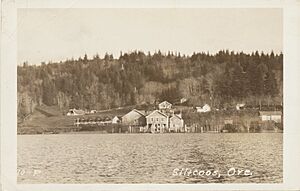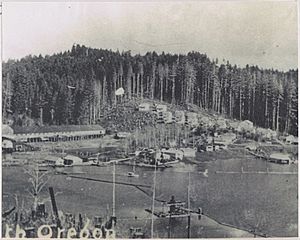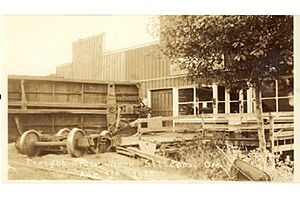Siltcoos, Oregon facts for kids
Siltcoos (also called Siltcoos Station) is a small community in Lane County, Oregon, United States. It is about 13 miles (21 km) south of Florence. You can find it on the east side of Siltcoos Lake.
The name Siltcoos comes from Native American languages. It might be the name of a local chief or a family. Another idea is that "Tsilt" and "Coos" means "plenty elk" in the Coosan language. This would refer to the many Roosevelt Elk that lived along the coast. The community's name was first spelled "Tsiltcoos." But in 1917, the Board on Geographic Names officially changed it to "Siltcoos."
In 1916, a train station called "Lane" was built here. It was part of the Southern Pacific Railroad's Coos Bay Line. This station was the last one in Lane County. A post office named Siltcoos also opened. In 1921, the train station's name was changed to match the post office, becoming Siltcoos Station. The Siltcoos post office closed in 1963, and mail then went to Gardiner.
Contents
Siltcoos: A Look Back in Time
Native American History
In 1848, the United States gained control of the Oregon Territory from the British. This was through a law called the Oregon Organic Act. This law was supposed to protect the land rights of Native Americans living there. It said that their rights to land would stay safe until a treaty was made. However, this promise was not kept.
By 1855, a large area called the Coast Indian Reservation was created. It was later known as the Siletz Reservation. This reservation covered over a million acres of the Oregon Central Coast Range. It stretched from Cape Lookout to the Siltcoos River's mouth. Native Americans who had been impacted by the Rogue River Wars in Southern Oregon were moved to this reservation. Life on the reservation was difficult for tribal members. They had to adjust to a very different environment on the central coast.
Soon, more white settlers wanted coastal land. In 1864, a stagecoach road was finished, connecting Eugene to the coast. By 1865, President Andrew Johnson allowed a large part of the reservation land to be given to white settlers. In 1875, an Oregon senator named John Mitchell worked to open the land between the Siltcoos River and Yaquina Bay for white settlement. In just a few years, the land set aside for tribes in the Siltcoos area was taken. Native Americans were moved to the Coast Reservation and the Grand Ronde Reservation.
The Christensen Family's Story
In 1892, a Danish immigrant named Neal Christensen settled in the Siltcoos area. He claimed the land under the Timber and Stone Act. Neal and his sons built docks and piers. These were used to ship supplies for building the "Lane" line of the SP Railroad.
The Christensen family was very resourceful. They planted apple and fig trees along the lake's shores. They also made money from farming red clover. They even created a ferry system using barges between nearby lakes. This system connected the roads to the railroad construction area. Small stagecoaches and narrow gauge rails linked the areas between the lakes.
In 1914, the railroad was finished. It included a railroad switch and a stop right in front of what became Siltcoos Station. Because of the railroad, small businesses like lumber mills and fishing resorts began to grow. More people moved to the lake area. The stagecoach road built by Christensen, which connected Woahink Lake and Siltcoos Lake, became known as Siltcoos Station Road.
By the 1910s and 1920s, the Christensens built a post office, a store, and a dance hall. They used a Scandinavian style, with steep roofs and buildings on stilts over the water. By the 1930s, they had built five cabins, a repair shop for boat motors, a gas station, and a school.
The Christensen family also ran a passenger service across the lakes. They had six gas-powered boats. One was on Woahink, one on Tahkenitch, and four on Siltcoos Lake. Materials for the railroad, like pilings and timbers, arrived by a narrow gauge railroad from the Siuslaw River at Glenada to the north end of Woahink Lake. This is where Honeyman Park is today. The Christensen family then used barges to tow these supplies across Woahink Lake and Siltcoos Lake to Ada. These supplies were used to build the railroad from Eugene to Coos Bay. The railroad passes along the east side of Siltcoos Lake.
Train services from Eugene to Coos Bay were common until the mid-1960s. Trains often stopped overnight at Siltcoos Station. Groups like the I.O.O.F. held weekly events on the trains. Dances at the hall during winter brought many people from the Willamette Valley.
However, accidents did happen. In April 1935, a train derailed in front of the store and dance hall. It almost crushed the three stilt buildings. A person on the train was trapped under the wreck, and locals had to dig him out. In the 1950s, a huge tree trunk floated down the Siltcoos River during a storm. It crashed into the stilts of the post office.
Siltcoos Station's Later Years
By 1972, fewer people lived in Siltcoos. This was partly because the Oregon Coast Highway and its bridges were completed. The Christensen family then donated Siltcoos Station to Lane Community College. The college used it as an art retreat for several years. However, the buildings were not well maintained.
In 2007, the buildings were in very bad shape. Lane Community College renovated them with help from community donations. But the college could not use the retreat as planned. So, in 2015, they sold it. All the money from the sale went to art scholarships, as the Christensen family had wished. The resort is now privately owned again. Work is being done to fully restore the docks and buildings.





